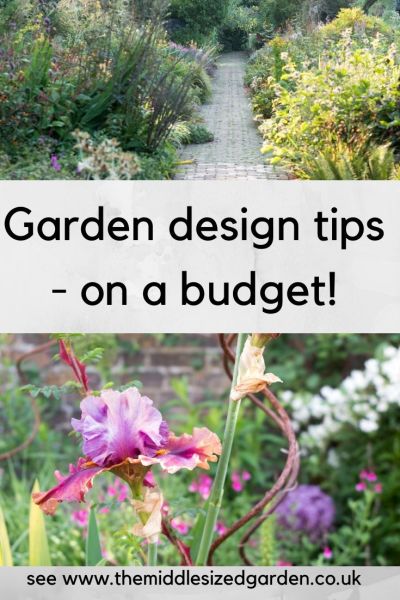How to save money on garden design
You can save money on garden design if you know what is worth doing properly and which elements can be added over time.
And you can also save money on garden design if you understand where the unexpected costs creep in.
I’ve been interviewing top designers for the Middlesized Garden blog and Youtube channel for nine years. And I’ve got a whole host of garden design and landscaping tips that will make your money go further.
Note: Links to Amazon are affiliate, see disclosure. I earn a small fee from qualifying purchases, but it doesn’t affect the price you pay. Other links are not affiliate.
Think of a word that sums up your garden
Garden designer and BBC Gardeners World presenter Adam Frost says ‘Think of a word that sums up your garden.’
If you’re saving money, you’ll often have to buy plants and furniture or do work over a number of years. To stop your garden looking like a muddle, ask yourself if it fits into your overall word.
This word could be calm, romantic, colourful or contemporary, rustic. It could save you a number of impulse purchases over the years.
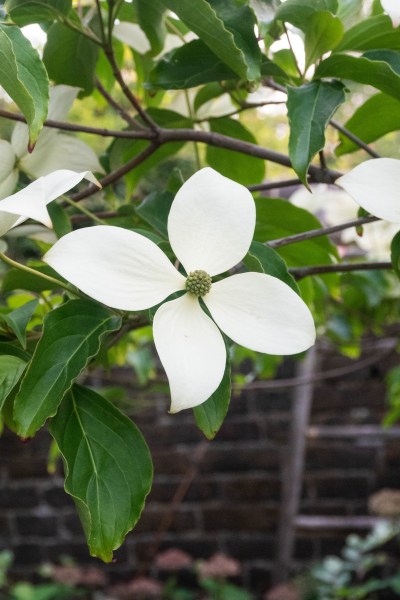
When garden designer Posy Gentles first started designing her garden, she chose the word ‘vintage’ to encapsulate what she was aiming at. This charming Cornus ‘Norman Haddon’ fits into that. Or it could fit into ‘white’, ‘contemporary’ or ‘plant lovers.’
This post on 12 garden styles will help you think about the word that defines your garden.
Start with the tree or trees
Make a tree or tree the anchor of your garden, says garden designer and BBC Gardeners World presenter Arit Anderson.
You can read more advice on garden design from Arit Anderson here.
If you already have a tree, but you don’t like it, consider whether expert pruning could transform it. A mature tree is very expensive, so if you can prune the tree you have, that will save money. See this post on how to prune garden trees for privacy and light.
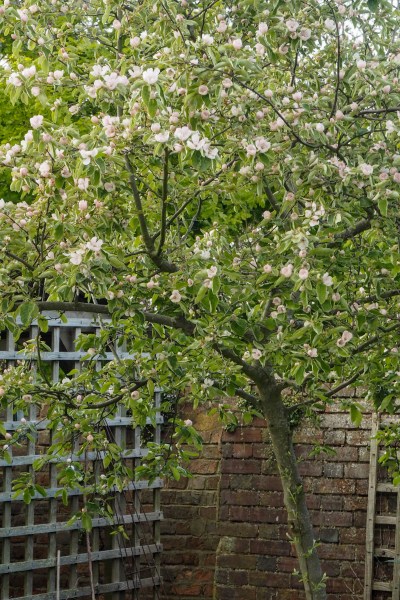
A fruit tree makes an excellent choice for a smaller garden. If you want to save money on garden design, then buy your trees very young. And they will establish better. I bought this quince as a very young sapling eleven years ago for £19, so they are not expensive.
If you are buying a new tree, a young one is much cheaper and will establish more quickly. But it’ll take a few years to get to where you want it to be. Find out more about how to choose the right tree for your garden here.
Small garden trees can make a big contribution to privacy in your garden, so if you want to feel more secluded, see this post on the best perfect-for-privacy trees.
Design the garden ‘off the house’
Award-winning garden designer Charlotte Rowe advises you always to design the garden ‘off the house’.
While this isn’t specifically a way to save money on garden design, it can stop you making mistakes. And mistakes are always expensive!
Designing ‘off the house’ means that you design where paths, terraces and focus points are by seeing how they look from the house. Don’t stand in the garden to design it – look out of the window or stand at the door.

Garden designed by Charlotte Rowe. Charlotte’s tips on garden design are always worth reading – see this post on 5 top garden design tips and how to avoid two common mistakes.
Charlotte also has some great advice for small urban gardens in
Measurements are key!
Both Charlotte Rowe and top garden designer Kate Gould advise that you should measure your garden carefully. And then measure it again.
Gardens are rarely exactly rectangular or square. And the smaller the garden, the more important it is to measure accurately.
If a garden is 40cm shorter on one side, and you’ve planned built-in storage or furniture, you may find that it doesn’t fit. So you may waste the money you spent on having those fittings made. Or you may find that you have bought too many or too few pavers.
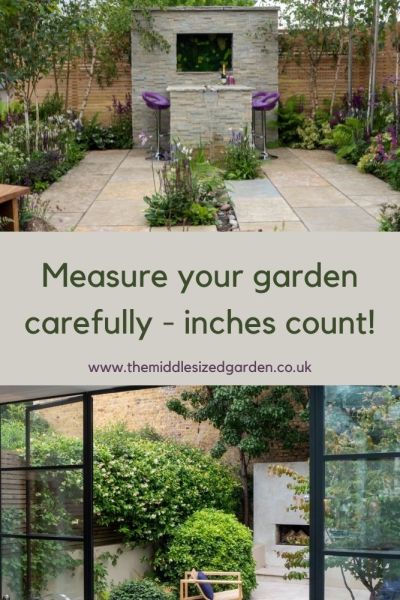
Save money on garden design by avoiding costly mistakes!
Garden designer Pollyanna Wilkinson advises you to look at where the sun falls. She has some good tips on how to design a garden here.
Your boundaries need to look good
This is another tip from Charlotte Rowe. ‘Your boundaries need to look good. If you can’t afford a new fence and it’s looking shabby, paint it black.’ Black makes a good background for plants and you can’t see flaws as easily as you can on a paler fence.
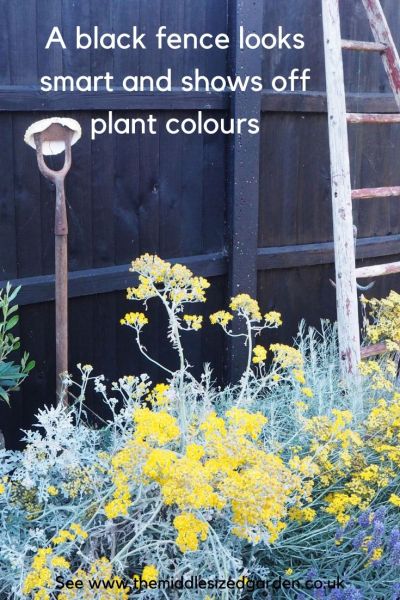
Before doing any work on fences or walls, check whether the boundaries belong to you.
You should ask your neighbour if you want to paint your side of your neighbour’s fence. Or you can run another fence along in front of it, or use planting to cover it.
Pick a signature colour as a theme
This is one of the cheapest ways to save money on garden design because you can smarten up your garden while spending very little. Garden writer Francine Raymond has two shades of paint – yellow and grey – to match her house’s yellow brick and grey slate roof. She buys pots and furniture from second-hand sales and supermarkets.
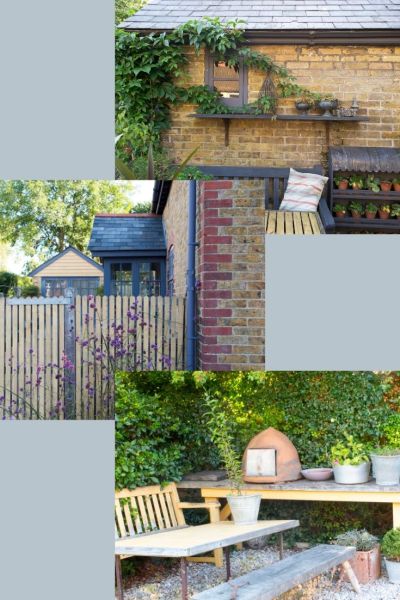
Francine Raymond’s yellow and grey theme is taken from the yellow bricks of her house and grey slate roof.
Once she has painted them with her signature colours, the whole garden looks smart and stylish.
See Francine’s brilliant budget ideas on turning a garage or shed into a garden room here.
And Robin and Margaret Marks chose an attractive mustard yellow colour to echo the cedar beams used in their home. They painted everything from window frames to bin storage and hand rails.
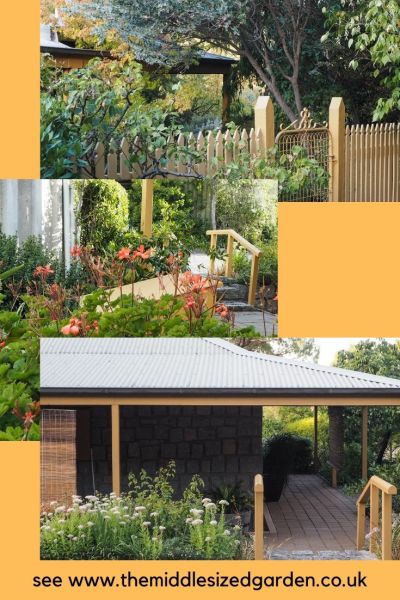
Robin and Margaret Marks took yellow as a signature colour for doors, window frames, fences, handrails, bins and more.
Save money on garden design by reducing waste
If you are hiring landscapers, then one of their costs is taking away soil, pavers, old wood structures etc.
When we landscaped our garden, we had it terraced. This meant some topsoil was scraped away. It was cheaper to have it relocated to raised beds in the vegetable garden rather than having it taken away. We also chopped up an old trellis and a rotten pergola to use for firewood.
Garden designer and BBC Bake off finalist Jane Beedle re-designed her garden. There was an old concrete terrace which had to come up. So she re-used old concrete pavers in her garden, by breaking them up and putting them in gabions.
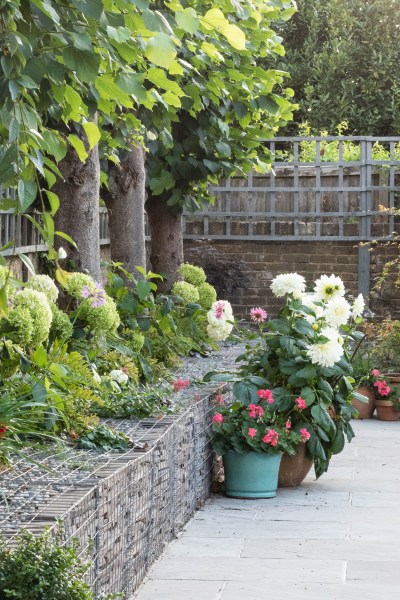
These wire cages in Jane Beedle’s garden are called gabions. The wire cages keep the soil away from the trunks of the trees – you couldn’t normally surround tree trunks with soil and broken pavers, but the gabions mean there is a gap of around six inches around each tree.
Gabions are wire cages full of stones or rocks. They’re used for sea defences but have recently become fashionable in gardens. Gabions make a great home for wildlife. And they look stylish.
You can also use sites Freegle or local Facebook groups to find people who will come to take pavers or other materials away. There’s more about this in How to declutter your shed.
Or save money by upcycling what’s there
Look at how to reuse what you already have in the garden. You can see an ugly concrete path in the picture below. The owners used bricks and stones to create pretty mosaic patterns where the concrete had broken.
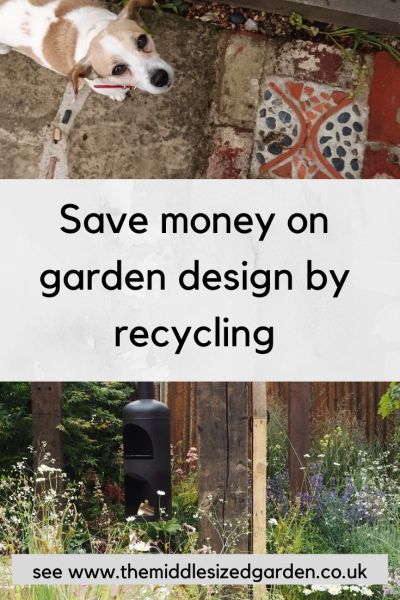
The top picture shows pottery and brick fragments inserted into a concrete path. The photo below shows a recycled gas cylinder used as a garden fire by Peter Cowell of Living Design. He also used scaffolding boards to make a pergola.
There are some lovely upcycling and recycling ideas from BBC Gardeners World Live here.
Buy second-hand…
Second hand garden furniture is harder to find than indoor furniture because furniture deteriorates outside. But it’s still usually cheaper than buying new.
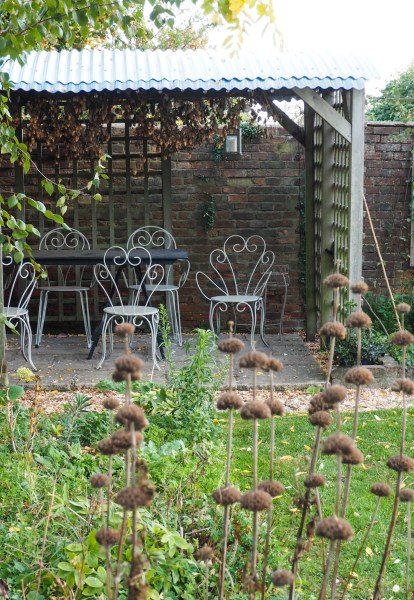
Two different sets of chairs were bought second-hand at different times and then painted to match. The table was made out of marine grade ply and the gazebo is a standard wooden pergola with a corrugated iron roof added to it.
But don’t just think about furniture that’s made for gardens. For example, you could paint metal office furniture with weatherproof paints and use it outside.
It’s also worth keeping an eye on exchange sites, such as Freegle or local Facebook groups. People are often happy to give away furniture rather than throw it away.
Save money on your garden paths
It’s expensive to lay down a path. Mulch and mown paths are the cheapest, followed by gravel or seashell paths. You can also mow or mulch a path yourself, which saves hiring garden landscapers.
But all these paths require maintenance. You’ll need to re-mow a path every few weeks in the growing season. And you’ll need to top up a gravel or seashell path every five-to-ten years. It depends how fussy you are about the finish!
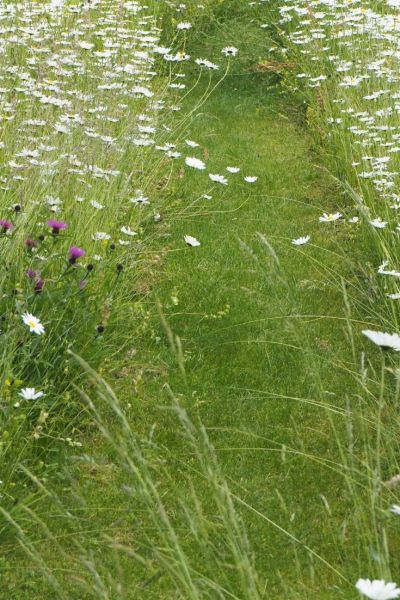
A mown path needs re-mowing every few weeks but it does give you the chance to decide where your path should go, as you can change it very easily.
However, it’s worth thinking carefully about your choice of a garden path in the context of your house’s design.
Longer lasting but more expensive garden paths
Decking is next up in price. It can look very attractive, but can be slippy when wet or in winter.
Stone and brick paths are very hard-wearing and low maintenance but they are the most expensive. However, the advantage of having a mown or a mulch path is that you can change it easily. By the time you’ve got the cash to buy the brick or stone, you’ll know exactly where you want your path to go.
Find out more here about how to choose garden path materials.
If you want your garden to be accessible, you’ll need a hard garden path. In which case gravel is cheapest. Provided it is laid properly, then it is also wheel friendly. Garden designer and BBC Gardeners World presenter Mark Lane has gravel paths throughout his garden. See more about laying gravel paths and other accessible garden design tips here.
Steps and paths are often linked. It’s important to choose the right materials for steps and to lay them in the right proportions. Find out what you need to know about garden steps here.
Mix garden path or terrace materials
You can also mix your path materials into a pattern of pavers, bricks and stones. You may be able to find short runs of brick or stone in sales or left over from another projects. Or you can buy pavers second-hand at architectural salvage stores or online. However, be careful that a mix of paving materials is laid properly or you may create a trip hazard.
Garden designer Posy Gentles has two terraces in her long narrow garden. She laid them at different times and with different materials. But they still look harmonious because they are the same yellow brick as the house.
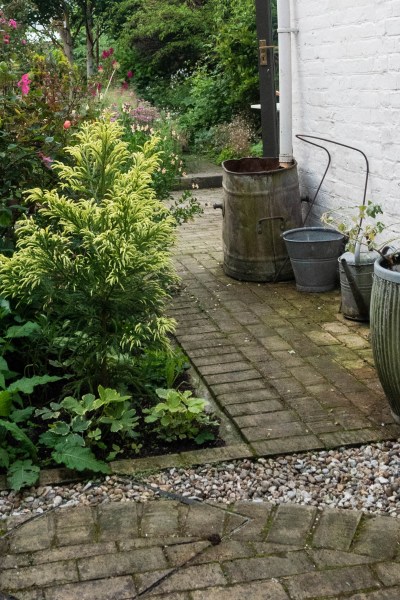
By choosing a brick that’s harmonious with her yellow-brick terraced house, Posy Gentles has been able to lay two terraces at different times, using small batches of brick. With wear the bricks seem to match.
And if you want to save money on garden design, you can create different areas in your garden at different times. Perhaps you ultimately want two terraced eating areas in your garden? Leave one as lawn until you can afford to have it paved over.
If you choose materials which go with your house or you have a theme for your garden, then it won’t matter so much if the two terraces are in slightly different materials.
Which hard landscaping is the most environmentally friendly?
All hard landscaping has an impact on the environment. If you want to minimise this, the Society of Garden Designers says you should start by trying to use as little hard landscaping as possible.
The next step, they say, is to try to reuse what you already have. That will save money on your garden design, too.
Then consider how far any new hard landscaping materials will have to travel to get to you. And finally, they suggest you consider what will happen to your hard landscaping in 100 years time.
For example, artificial grass has a lifespan of 10-15 years and it’s difficult to recycle it. In 100 years time, it will still be contributing to landfill, as will composite or pressure-treated decking. Composite and pressure treated decking typically has a 30 year lifespan, but it can’t easily be recycled, burned or composted because of chemicals in it.
Stone and brick can often still be used when they are 100 years old.
Saving money on garden ponds
The cheapest way to create a pond is simply to dig a hole. Then cover it with a plastic pond liner or a rigid ‘pre-formed’ pond liner. Use rocks or stones to hold the pond liner in place and disguise the edge. And fill with water.
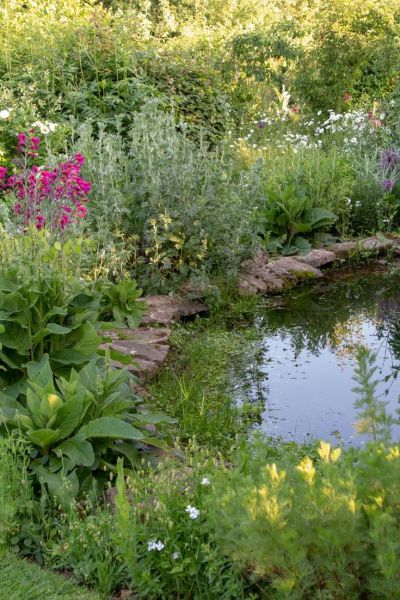
This pond was dug out with a spade and lined with pond plastic. Rocks on the edge keep the pond plastic in place.
Always make sure that the sides are gradual – small creatures need to be able to get in and out. And make sure that babies and small children cannot have access.
Here are more ideas for garden ponds. You can also transform a tub or trough into a garden pond without spending too much – see how to create a mini wildlife pond.
Saving money on plants
Filling a border with plants will cost you hundreds of pounds if you do it all at once. But I think it is probably better to prioritise your spending on the hard landscaping – the terrace, the paths and any structures – because planting is something you can develop over time.
Once you have laid a terrace or a path or built a pergola, you’re not going to change it. So don’t save money on garden design – buy the best you can afford. Save money on plants, at least at the beginning. There’s more about saving money on gardening here.
Learn how to propagate plants or grow them from seed. The best seeds to sow directly into the ground are the wildflower meadow mixes, such as the Empathy Mini Meadow Mix . But it’s usually much better to sow most other seeds into trays or a propagator, then plant them out when they’re big enough.
You can ask friends if they have any spare bulbs if they are digging them up after flowering in spring. And in autumn many people divide their perennials plantings so they often have spare pieces of root.
And if anyone wants to give you a present, perhaps you can make it known that you would like a particular kind of rose or packet of dahlias.
Read the complete cost breakdown on planting up a border in how to make a garden border on a budget.
The key to choosing plants
Most importantly, when you do spend money on plants, check how big the plant is going to grow, whether it is suitable for your soil and the sunshine in your garden. Look at its foliage or shape. If you get all this right, you can save money by buying small plants which will grow bigger quite quickly.
Most of us choose plants for their flowers, but often they are only out for a few weeks a year. And if you buy plants in a supermarket or large garden centre, they may have been forced to be extra flowery when you buy them, but they may not grow like that in your garden in future years.
If, however, a plant has a striking shape or dramatic leaves, then it will add interest to your garden for months on end.
Perennial plants will come back in your garden year after year. So you only have to buy them once. Find out more about choosing and growing perennials in this post on perennials made simple.
And when you do spend money on plants, make sure that you – or someone else – waters them and looks after them at least for the first year. All plants need a little extra help to get established, although many are quite low maintenance after that.
Find out more about saving money on gardening in this post.
Save money on garden design – lighting
Garden lighting is another expensive element, but it is much better to plan it in and dig in the cables when you are having a major garden re-design. It’s difficult – and therefore more expensive – to retro-fit it.
Garden lighting which involves electrical cables should also by law (in most countries) be fitted by someone who is qualified to do it. Even if you really are a very competent DIY-er, you will have to check your local building controls regulations.
The cheaper, easier alternative is to use solar lighting. Either you buy individual lights, each fitted with a small solar panel or a string of lights with a solar panel. These small panels must be in sunshine for most of the day (6-8 hours) to work.
And, obviously, they re-charge less in winter if you have shorter days and less sunlight. Which means they also work for fewer hours in winter.
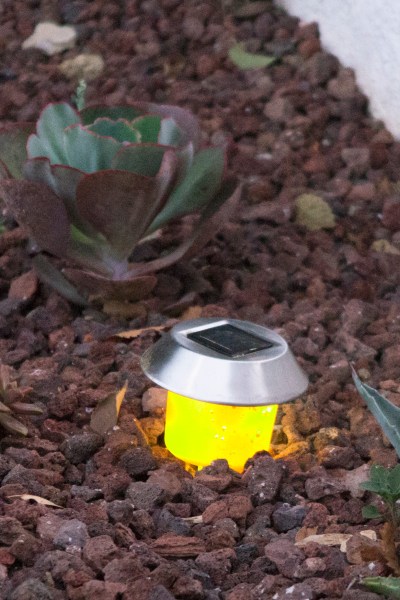
This solar light illuminates a path in Spain – but it is in a very sunny spot! Note the tiny solar panel on top of the light. This needs to be in full sun for several hours a day in order to work!
I think solar lights are pretty, but I haven’t yet found any that give the dramatic lighting effects that you get with proper mains garden lighting.
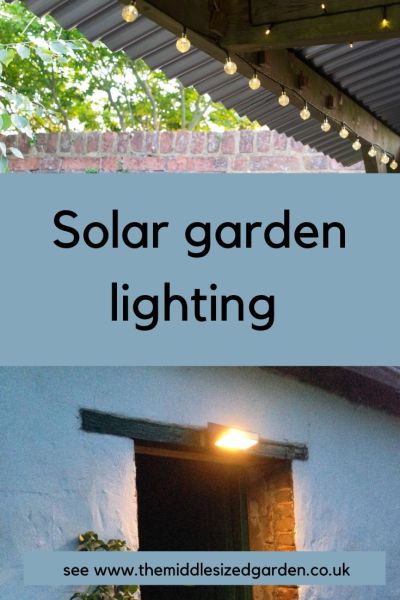
Solar garden lighting. We’ve had a string of solar fairy lights up in our garden for two years now. The light below is a Philips and it has been doing duty over this door for three years. I couldn’t find the exact light, but Philips have a similar one called the Philips My Garden Moon Solar LED wall light.
Generally if you are having landscaping or major building work done, it’s an ideal opportunity to make sure that you are installing the water and electrical supplies you need. And you definitely need at least one outside tap and probably some form of outdoor electrical supply.
Saving money on garden pots
Garden planters and pots can also be expensive. Large pots are easier to look after than having lots of small pots, because large pots hold water better. Small pots dry out very quickly.
So I would advise spending your money on one large pot instead of lots of small ones. I’ve picked up my largest pots as seconds when visiting pot makers or in sales. One of these has a firing crack in it, so I turn that away from the house.
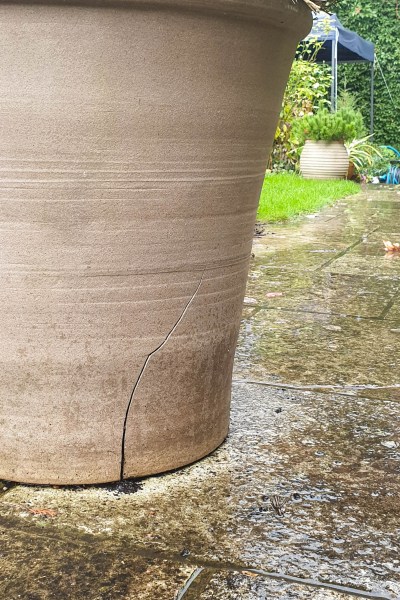
This is a ‘firing crack’ and means that the pot only cost me £18 (instead of £180). A firing crack won’t affect whether a pot is frost-proof, but you should check.
Check that pots are frost-proof – it’s a shame to spend a lot of money on a pot that cracks in winter.
And if you’re buying standard pots from a garden centre, you can paint them in your garden’s signature colour to make them look more special. Chalk paints, such as the Shabby Chic range, can be used on wood, pottery, plastic, metal and other surfaces.
Saving money on garden sheds
Once again, if you repair and paint an old shed, it can transform it for much less than buying a new shed. However, it can still be expensive. It cost us several hundred pounds to re-roof our potting shed.
There’s some colour inspiration here in What Colour Shall I Paint My Shed.
One thing to bear in mind if you’re buying a new shed – you need a good base, preferably of brick or concrete. Shed bases are often sold separately so you can choose, but a wooden base will rot over time. And if your shed base is unstable, the shed structure will start to move.
Here’s a post about what you need to know if you’re trying to decide whether to buy a new garden shed or repair the old one.
See the video for money-saving tips on garden design
You can see more of the gardens in this video about saving money when you’re planning your garden.
So how much does a garden design cost?
Although people are often willing to spend tens of thousands on a new kitchen or bathroom, they are sometimes surprised at how much designing and landscaping a garden can cost.
If you want to save money on garden design, you could hire a garden designer to draw up plants but manage the project yourself. That means you pay for the designs, but you find the specialist workmen to carry out the work. The designs alone will probably cost around £50-£150 an hour or around £3k-£10k, including detailed plans that the specialists can work to.
Or you can ask the garden designer to project manage the work. They would charge a percentage of the cost of the job, on top of the design fees. Typically that would be 10%-20%.
How to find a garden designer
You can find a garden designer via the Society of Garden Designers or ask around locally. There’s no exact way of finding out how much a garden design should cost. But it’s generally accepted that a well designed and maintained garden could add 5-10% or more value to your home. So take that as a starting point.
For example, the average home in the UK is worth around £232k. So the average home owner could, in theory, budget to spend £15k-£30k on creating a beautiful garden. In reality, most garden re-designs are between £20k and £100k. That includes the designs, planting and all the structural work.
More information on garden design
Think about the essentials of garden design, which I learned from a one day course at the KLC School of Design.
Landscaping is the most expensive part of garden design. That means -digging and laying paths, walls and terraces etc. So find out more about what to look for in a landscaping company. I asked garden consultant Matt Jackson of Land & Heritage, who specialise in landscape management and restoration for his 12 professional insider tips for landscaping your garden.
Adam Frost’s book How to Create Your Garden is full of really good advice for anyone thinking of re-vamping their garden.
Pin to remember how to save money on garden design
We regularly cover garden design, as well as planting and visits to both private and public gardens. So if you’d like a free weekly email with gardening tips, ideas and inspiration, see here.
